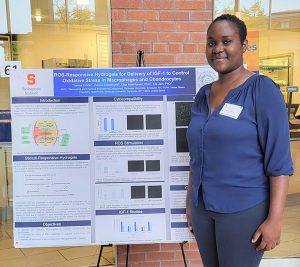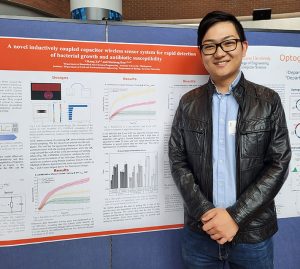Two graduate student researchers in the BioInspired Institute research cluster were among 57 students and post-doctoral fellows presenting posters and talks at the institute’s first symposium earlier this month.
We caught up with Thalma Orado, a first-year Ph.D. student in Assistant Professor Era Jain’s drug delivery lab, and Yikang Xu, a fourth-year Ph.D. student in Professor Dacheng Ren’s biofilm engineering lab. Orado (bioengineering) and Xu (biomedical and chemical engineering) in the College of Engineering and Computer Science offer insights about why they chose Syracuse University, what’s best about graduate student life here, their research work and their career plans.
Thalma Orado
 Why did you choose Syracuse for your graduate studies?
Why did you choose Syracuse for your graduate studies?
I came here from Kenya when my husband entered the master’s program in African American studies. He finished in 2021 and now works in Syracuse. He introduced me to someone who suggested that with my background in biochemistry I should apply to the doctoral program. My mother is a professor of science ed—she earned a Ph.D. at Syracuse in 2014, and it’s always been my interest to pursue science. The sciences are what produce solutions to problems in this world.
What’s the best thing about your graduate school experience so far?
My advisor [Era Jain]! She is very supportive and understanding. I’m very busy as a Ph.D. student, researcher, teaching assistant, wife and mother to two young children. At some point I was overwhelmed and almost gave up. My advisor told me, “We are not giving up, we are pursuing this [degree] through to the end.” It’s very clear she’s not giving up on me. So, if she’s not ready to quit, then who am I to quit? It’s good to have advisors and mentors; they help shape us and encourage us our doctoral journeys.
What is your research about?
My project examines factors that create pain and inflammation in such diseases as osteoarthritis. Cells produce an abundance of reactive oxygen species (ROS) in osteoarthritis, which causes pain and inflammation. But with a specific hydrogel created in Olga Makhlynet’s chemistry lab, we can leverage the ROS chemicals and help alleviate the inflammation. We are studying how the hydrogel behaves with the chosen drug. Once the drug is in the hydrogel, it can stay in the knee joint longer, and that’s important. With increases in the aging population, something like this can make a big difference to people all around the world.
What is your advice for other graduate students?
Graduate school and all it entails can be a lot to bear, so acknowledging what’s stressing you is important. The next step is finding resources to help support you. Being open to other people about what you’re experiencing allows them to help you along the way. It’s difficult to do it alone but it’s amazing how much you can accomplish in life if you put your mind to it. In Swahili we have a saying, “Once you put the water in for a bath, you have to take the bath, because you’ve already [invested] the water.” So, don’t be afraid to commit. If you feel you have a calling or a passion, go for it and figure out the rest as you go along. You just have to be brave in life, I guess.
Yikang Xu
 Why did you decide on Syracuse for your doctoral program?
Why did you decide on Syracuse for your doctoral program?
I was at Ohio State looking at schools for graduate research, and the Syracuse University website and biomedical and chemical engineering program interested me. I was offered a generous tuition scholarship after I applied for the master’s program, and I thought, if they want me, I’m here! And after a semester here, my principal investigator invited me to transfer to the Ph.D. program. I’m really glad that I took that opportunity.
What’s been the best thing about your graduate school experience?
The Syracuse Biomaterials Innovation Facility is really good. There are common spaces for different departments and colleagues from completely different fields there, and always someone to bounce an idea off. The clashing of the minds when you have people of different backgrounds coming at a project from different angles is especially helpful. That helps me by ensuring that I don’t feel overly confident. It helps me realize there are things I don’t know and there are always things you can learn from other people.
What is your research project?
We have engineered a wireless electrochemical biosensor system that provides rapid antibiotic susceptibility testing. It provides fast and potentially low-cost testing for antimicrobial resistance.
The project is working out pretty well, and that’s good, since we went into it not knowing if it was going to work. The direction for my initial project was for me and my principal investigator to take a shot in the dark—buy the equipment then see if the experiment works. I’ve spent most of my three years here polishing my idea, optimizing my system and making the results better and better. Now, I have a very sensitive working system and my journal article is drafted and ready to go out soon. After all these years, the work is paying off.
What is your advice for other graduate students?
Learn to think critically; it’s a skill everyone eventually has to learn. You need to do that long-term because a solution could be hidden anywhere. There is competition among people working toward the same goals, so you have to be more thorough to come out on top in what you want to achieve.
I’ve seen colleagues who have worked on a project for two to three years with seemingly discouraging results, but very rarely did they give up. You have to overcome your fear because even if the hypothesis is refuted, you have to work to prove that, too. As a scientist, you want to find out the truth. If your solution doesn’t work well, no one wants that, but you just have to start over, you have to start again on something else.
By Diane Stirling
